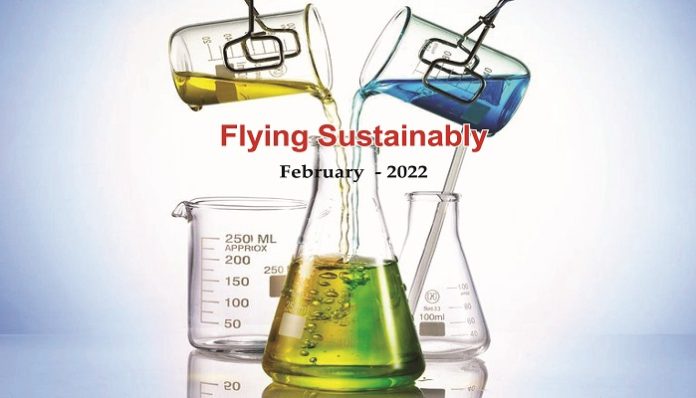Pledges on net-zero emissions and sustainability are compelling the aviation industry also, which accounts for approximately three percent of global emissions, to cut emissions. But this is easier said than done due to specific characteristics of planes, which make alternatives, like battery, hydrogen, etc difficult to consider as of today. However, aviation fuel made from renewables is showing promise. This month’s column examines this in detail.
The Indigo A320 flight from Toulouse, France to New Delhi on 17th/18th February was special because it used a blend of Sustainable Aviation Fuel (SAF) and conventional jet fuel. It was the first international flight using SAF by an Indian carrier. Earlier on 1st December last year, United Airlines had created aviation history by operating its 737 MAX8 flight from Chicago to Washington DC, with 115 passengers on board, by using 100 percent SAF for one of its two engines. As required by regulation, the other engine used conventional jet fuel and in the process the airline was able to demonstrate that there are no operational differences between the two types of fuel. Welcome to the era of sustainable flying.
Sustainability
SAFs are made from renewable feedstocks. These include food waste, animal waste, agricultural waste and municipal solid waste. Wood waste and plastic waste are also being proposed as feedstocks to produce SAF. They have also been synthesised from carbon dioxide and hydrogen. Because no modifications are permitted on proven and tested jet engines, SAFs have to be chemically identical to conventional jet fuels regardless of the feedstock. Hence the amount of carbon dioxide released in the combustion process during the flight is exactly the same. The sustainability dimension comes from the life cycle of the SAF. Since the carbon dioxide released is the same as that sequestered during the growth of the biomass feedstocks, the net release is close to zero. Similarly, synthetic SAF produced from carbon dioxide using only renewable energy will have net emission close to zero. The actual benefit accrued from the use of SAF depends on the feedstock used and how it is processed.
HEFA
The most commonly used method for production of SAF is the Hydroprocessed Esters and Fatty Acids (HEFA) process, in which vegetable oil or animal fat is reacted with hydrogen in the presence of a catalyst. HEFA-based fuel was approved by ASTM in 2011 and can be blended up to 50 percent with conventional jet fuel. Over 95 percent of all SAF based flights so far have used fuel produced by HEFA process. Neste Oil of Finland and UOP are the two major licensors of this process. The reaction is carried out at temperature of around 400 degrees C and 100 bar pressure. The catalyst is typically palladium supported on alumina. Essentially three reactions take place during the process. In the first, the unsaturated triglycerides are saturated using hydrogen. In the second step, a propane molecule is cleaved off from the hydrogenated product leaving behind free fatty acids. The third step is the decarboxylation of the fatty acids to yield straight chain paraffin. The paraffin is next hydrocracked and hydroisomerised to produce Synthetic Paraffinic Kerosene (SPK) of the required specifications.
Fischer Tropsch Synthesis
Another technology for the production of SAF that is gaining ground is the nearly 100-year-old Fischer Tropsch (FT) synthesis. The process gasifies solid biomass, typically wood waste, at high temperatures to generate “syngas”, a mixture of carbon monoxide and hydrogen, which after purification are catalytically combined to yield hydrocarbon chains of different lengths. Johnson Matthey has developed a reverse water gas shift process in which green hydrogen is catalytically reacted with captured carbon dioxide to form carbon monoxide. This carbon monoxide along with additional hydrogen forms the “syngas”, the building block for fuels by FT synthesis.
Approvals
Safety is top priority in aviation and hence all new fuels are put through rigorous trials. To avoid redesign or modification of existing engines, regulators demand that SAF has the exact same chemical characteristics as convention fuel. Tests are carried out both in laboratory and air and also includes simulating unusual conditions. Presently, SAF is allowed to be blended with conventional fuels up to a maximum of 50 percent. The limit is expected to be withdrawn in the foreseeable future. Eight different processes for the production of SAF have been currently approved by the ASTM D7566 standard. The HEFA process and Fischer Tropsch synthesis are among them. Other processes include Synthetic Iso-Paraffin (SIP) by fermentation of sugar and Alcohol to Jet Fuel (ATJ) conversion process starting from isobutanol.
Decarbonisation
Aviation industry currently emits 1.2 billion tons of carbon dioxide annually, accounting for approximately 3 percent of global emissions. With more and more people flying for business and leisure this is only bound to go northwards. Aviation industry aims to cut emissions by 50 percent by 2050 compared to its 2005 level. Unlike surface transportation, decarbonisation of aviation is not easy. Planes need to be lighter to be able to fly and also to carry enough energy for the entire duration of their flight. The high energy densities of liquid fuels cannot be matched by hydrogen or batteries. A Boeing 737 weighing 90 tonnes at takeoff would need 600 tons of lithium battery to match the energy content of jet fuel. Similarly, a 737 would need to fill half its volume with liquid hydrogen to be able to complete its journey. Electrical and hydrogen propulsion, though technically feasible, are decades away from commercialisation. The industry thus pins its hopes on SAF to meet its 2050 target.
Economics
The economics of SAF is currently very unfavourable. Depending on the feedstock, SAF can be between two and four times more expensive than conventional jet fuel. More importantly, there isn’t enough feedstock available for the accelerated adoption of SAF. The present SAF production is able to meet just 0.05 percent of the global demand. A working paper from International Council on Clean Transportation estimates that the feedstock availability would be able to support only 5.5 percent of the projected demand for jet fuel in 2030. Some experts are cautioning against SAF competing for agricultural land that is presently being used for food and surface transportation biofuels. In the near term, SAF’s share will increase only by government intervention through subsidies, tax incentives and mandating a certain minimum blend.
Epilogue
Decarbonising aviation is difficult and the industry has set for itself a very ambitious target. So far, the industry’s success has been in conducting trials to demonstrate the performance of SAF and establish its integration into existing fuel supply chains. Much needs to be done before SAF really takes off.
Readers’ responses may be sent to:
k.sahasranaman@gmail.com or
chemindigest@gmail.com
































